Space in expansion does in fact compass to a posture of comprehending the yard of the universe. To thought the 'Black Hole' is a dynamic of depth to Space in a vacuum. The expansion of breath as 'Matter' to the take of one Universe into another would in thought solve Beta. The 'Mother's Milk' in position to identify the parent system in the Orion's Solar System to possibly dial (Mathematics) life. The sign is on it's residence as in the Greek System it is shown as standing (B,β), battling for air so to speak, would or could show the lie of position as dead. Perhaps the Egyptian Wall would show the breast as in breasting or to breast the wave or "Breasting definition, a piece of leather or other material for covering the heel breast of a shoe." https://www.dictionary.com/browse/breasting
Perhaps the horn of the Four Horsemen in story would carry this a bit further.
〄 1st thought: The bodies are energy showing the centrifugal force as push and pull:
"Energy equals mass times the speed of light squared." On the most basic level, the equation says that energy and mass (matter) are interchangeable; they are different forms of the same thing. Under the right conditions, energy can become mass, and vice versa. NOVA; https://www.pbs.org/wgbh/nova/einstein/lrk-hand-emc2expl.html
"In the equation, the increased relativistic mass (m) of a body times the speed of light squared (c2) is equal to the kinetic energy (E) of that body. In physical theories prior to that of special relativity, mass and energy were viewed as distinct entities."
How do you find centrifugal force?
Follow these simple steps:
- Find the mass of the object - for example, 10 kg .
- Determine the radius of rotation. Let's assume it's 2 m .
- Determine the velocity of the object. It can be equal to 5 m/s . ...
- Use the centrifugal force equation: F = m * v^2 / r . ...
- Or you can just input the data into our calculator instead :)
〄 Reference to out-post for monopoly〆
"Squash is a ball sport played by two (singles) or four players (doubles squash) in a four-walled court with a small, hollow rubber ball. The players must alternate in striking the ball with their racquet and hit the ball onto the playable surfaces of the four walls of the court." https://en.wikipedia.org/wiki/Squash_(sport)
Object of the Game
The object of the game is hit the ball off the back wall until you manage to make your opponent fail in returning the ball. Every time you do so you will receive a point. Points make up sets, which in turn determine the winner of the match. http://www.rulesofsport.com/sports/squash.htmlThe Greek alphabet has been used to write the Greek language since the late ninth or early eighth century BC.[3][4] It is derived from the earlier Phoenician alphabet,[5] and was the first alphabetic script to have distinct letters for vowels as well as consonants. In Archaic and early Classical times, the Greek alphabet existed in many different local variants, but, by the end of the fourth century BC, the Eucleidean alphabet, with twenty-four letters, ordered from alpha to omega, had become standard and it is this version that is still used to write Greek today. These twenty-four letters are: Α α, Β β, Γ γ, Δ δ, Ε ε, Ζ ζ, Η η, Θ θ, Ι ι, Κ κ, Λ λ, Μ μ, Ν ν, Ξ ξ, Ο ο, Π π, Ρ ρ, Σ σ/ς, Τ τ, Υ υ, Φ φ, Χ χ, Ψ ψ, and Ω ω.
The Greek alphabet is the ancestor of the Latin and Cyrillic scripts.
Parent systems
Egyptian hieroglyphs https://en.wikipedia.org/wiki/Greek_alphabetJet Engines; https://www.explainthatstuff.com/jetengine.html
by Chris Woodford. Last updated: April 22, 2018.
Turn your eyes to the sky and it's likely you'll see more than a
few vapor trails—the wispy white lines that jet planes scribble on
the great blue canvas stretched above our heads. At the dawn of the
20th century, the very idea of powered flight seemed, to many, like a
ludicrous dream. How things have changed! At any given moment,
there are something like 7,000 flights zipping through the sky over the United States alone;
we're so used to the idea of flight that we barely even
notice all the planes screaming above us, hauling hundreds of
people at a time to their homes and holidays.
Most modern planes are powered by jet engines
(more correctly, as we'll see in a moment, gas turbines).
What exactly are these magic machines and what makes them different
from the engines used in cars or trucks?
Let's take a closer look at how they work!
Photo: A jet engine taken apart during testing.
You can clearly see the giant fan at the front. This spins around to suck air into the
engine as the plane flies through the sky. Picture by Ian Schoeneberg courtesy of
US
Navy.What is a jet engine?
A jet engine is a machine that converts energy-rich, liquid fuel into a powerful pushing force called thrust. The thrust from one or more engines pushes a plane forward, forcing air past its scientifically shaped wings to create an upward force called lift that powers it into the sky. That, in short, is how planes work—but how do jet engines work?Jet engines and car engines
One way to understand modern jet engines is to compare them with the piston engines used in early airplanes, which are very similar to the ones still used in cars. A piston engine (also called a reciprocating engine, because the pistons move back and forth or "reciprocate") makes its power in strong steel "cooking pots" called cylinders. Fuel is squirted into the cylinders with air from the atmosphere. The piston in each cylinder compresses the mixture, raising its temperature so it either ignites spontaneously (in a diesel engine) or with help from a sparking plug (in a gas engine). The burning fuel and air explodes and expands, pushing the piston back out and driving the crankshaft that powers the car's wheels (or the plane's propeller), before the whole four-step cycle (intake, compression, combustion, exhaust) repeats itself. The trouble with this is that the piston is driven only during one of the four steps—so it's making power only a fraction of the time. The amount of power a piston engine makes is directly related to how big the cylinder is and how far the piston moves; unless you use hefty cylinders and pistons (or many of them), you're limited to producing relatively modest amounts of power. If your piston engine is powering a plane, that limits how fast it can fly, how much lift it can make, how big it can be, and how much it can carry.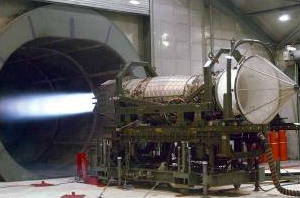
Photo: Massive thrust! A Pratt and Whitney F119 jet aircraft engine creates 156,000 newtons (35,000 pounds) of thrust during this US Air Force test in 2002. That sounds like a lot of power, but it's less than half the thrust produced by one of the vast jet engines (turbofans) on an airliner, as you can see from the bar chart further down this article. Picture by Albert Bosco courtesy of US Air Force.
A jet engine uses the same scientific principle as a car engine: it burns fuel with air (in a chemical reaction called combustion) to release energy that powers a plane, vehicle, or other machine. But instead of using cylinders that go through four steps in turn, it uses a long metal tube that carries out the same four steps in a straight-line sequence—a kind of thrust-making production line! In the simplest type of jet engine, called a turbojet, air is drawn in at the front through an inlet (or intake), compressed by a fan, mixed with fuel and combusted, and then fired out as a hot, fast moving exhaust at the back.
Three things make a jet engine more powerful than a car's piston engine:
- A basic principle of physics called the law of conservation of energy tells us that if a jet engine needs to make more power each second, it has to burn more fuel each second. A jet engine is meticulously designed to hoover up huge amounts of air and burn it with vast amounts of fuel (roughly in the ratio 50 parts air to one part fuel), so the main reason why it makes more power is because it can burn more fuel.
- Because intake, compression, combustion, and exhaust all happen simultaneously, a jet engine produces maximum power all the time (unlike a single cylinder in a piston engine).
- Unlike a piston engine (which uses a single stroke of the piston to extract energy), a typical jet engine passes its exhaust through multiple turbine "stages" to extract as much energy as possible. That makes it much more efficient (it gets more power from the same mass of fuel).
Gas turbines
A more technical name for a jet engine is a gas turbine, and although it's not immediately obvious what that means, it's actually a much better description of how an engine like this really works. A jet engine works by burning fuel in air to release hot exhaust gas. But where a car engine uses the explosions of exhaust to push its pistons, a jet engine forces the gas past the blades of a windmill-like spinning wheel (a turbine), making it rotate. So, in a jet engine, exhaust gas powers a turbine—hence the name gas turbine.Action and reaction
When we talk about jet engines, we to tend think of rocket-like tubes that fire exhaust gas backward. Another basic bit of physics, Newton's third law of motion, tells us that as a jet engine's exhaust gas shoots back, the plane itself must move forward. It's exactly like a skateboarder kicking back on the pavement to go forward; in a jet engine, it's the exhaust gas that provides the "kick". In everyday words, the action (the force of the exhaust gas shooting backward) is equal and opposite to the reaction (the force of the plane moving forward); the action moves the exhaust gas, while the reaction moves the plane.But not all jet engines work this way: some produce hardly any rocket exhaust at all. Instead, most of their power is harnessed by the turbine—and the shaft attached to the turbine is used to power a propeller (in a propeller airplane), a rotor blade (in a helicopter), a giant fan (in a large passenger jet), or an electricity generator (in a gas-turbine power plant). We'll look at these different types of gas turbine "jet" engines in a bit more detail in a moment. First, let's look at how a simple jet engine makes its power.
How a jet engine works
This simplified diagram shows you the process through which a jet engine converts the energy in fuel into kinetic energy that makes a plane soar through the air. (It uses a small part of the top photo on this page, taken by Ian Schoeneberg courtesy of US Navy.):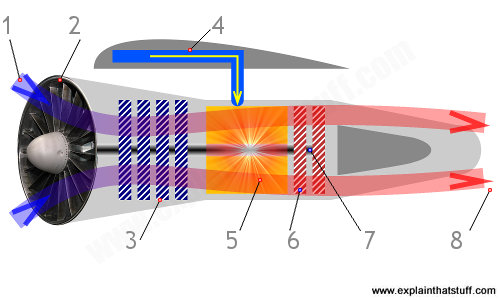
- For a jet going slower than the speed of sound, the engine is moving through the air at about 1000 km/h (600 mph). We can think of the engine as being stationary and the cold air moving toward it at this speed.
- A fan at the front sucks the cold air into the engine and forces it through the inlet. This slows the air down by about 60 percent and its speed is now about 400 km/h (240 mph).
- A second fan called a compressor squeezes the air (increases its pressure) by about eight times, and this dramatically increases its temperature.
- Kerosene (liquid fuel) is squirted into the engine from a fuel tank in the plane's wing.
- In the combustion chamber, just behind the compressor, the kerosene mixes with the compressed air and burns fiercely, giving off hot exhaust gases and producing a huge increase in temperature. The burning mixture reaches a temperature of around 900°C (1650°F).
- The exhaust gases rush past a set of turbine blades, spinning them like a windmill. Since the turbine gains energy, the gases must lose the same amount of energy—and they do so by cooling down slightly and losing pressure.
- The turbine blades are connected to a long axle (represented by the middle gray line) that runs the length of the engine. The compressor and the fan are also connected to this axle. So, as the turbine blades spin, they also turn the compressor and the fan.
- The hot exhaust gases exit the engine through a tapering exhaust nozzle. Just as water squeezed through a narrow pipe accelerates dramatically into a fast jet (think of what happens in a water pistol), the tapering design of the exhaust nozzle helps to accelerate the gases to a speed of over 2100 km/h (1300 mph). So the hot air leaving the engine at the back is traveling over twice the speed of the cold air entering it at the front—and that's what powers the plane. Military jets often have an after burner that squirts fuel into the exhaust jet to produce extra thrust. The backward-moving exhaust gases power the jet forward. Because the plane is much bigger and heavier than the exhaust gases it produces, the exhaust gases have to zoom backward much faster than the plane's own speed.
- Compressor: Dramatically increases the pressure of the air (and, to a lesser extent) its temperature.
- Combustion chamber: Dramatically increases the temperature of the air-fuel mixture by releasing heat energy from the fuel.
- Exhaust nozzle: Dramatically increases the velocity of the exhaust gases, so powering the plane.
Whittle's engines
British engineer Sir Frank Whittle (1907–1996) invented the jet engine in 1930, and here's one of his designs taken from a patent he filed in 1937. As you can see, it bears a resemblance to the modern design up above, although it works a little differently (most obviously, there is no fan at the inlet). Briefly, air shoots in through the inlet (1) and is pressurized and accelerated by a compressor (2). Some is fed to the engine (3), which drives a second compressor (4), before exiting through the rear nozzle (5). The rear compressor's exhaust drives the compressor at the front (6).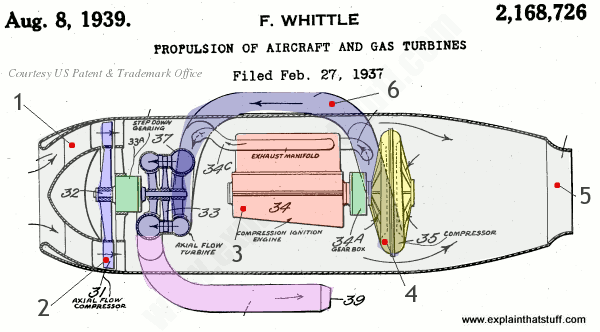
Types of jet engines
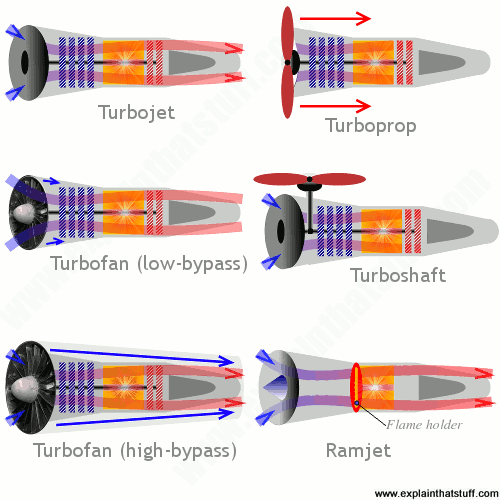
Artwork: A summary of six main types of jet engine. Each one is explained further in the text below, followed by a link to an excellent NASA website where you'll find even more graphics and animations.
All jet engines and gas turbines work in broadly the same way (pulling air through an inlet, compressing it, combusting it with fuel, and allowing the exhaust to expand through a turbine), so they all share five key components: an inlet, a compressor, a combustion chamber, and a turbine (arranged in exactly that sequence) with a driveshaft running through them.
But there the similarities end. Different types of engines have extra components (driven by the turbine), the inlets work in different ways, there may be more than one combustion chamber, there might be two or more compressors and multiple turbines. And the application (the job the engine has to do) is also very important. Aerospace engines are designed through meticulously engineered compromise: they need to produce maximum power from minimum fuel (with maximum efficiency, in other words) while being as small, light, and quiet as possible. Gas turbines used on the ground (for example, in power plants) don't necessarily need to compromise in quite the same way; they don't need to be either small or light, though they certainly still need maximum power and efficiency.
Turbojets
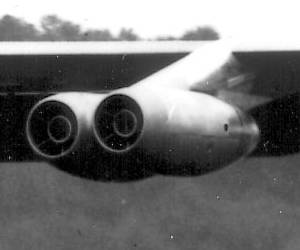
Photo: Early Turbojet engines on a Boeing B-52A Stratofortress plane, pictured in 1954. The B-52A had eight Pratt and Whitney J-57 turbojets, each of which could produce about 10,000 pounds of thrust. Picture courtesy of US Air Force.
Whittle's original design was called a turbojet and it's still widely used in airplanes today. A turbojet is the simplest kind of jet engine based on a gas turbine: it's a basic "rocket" jet that moves a plane forward by firing a hot jet of exhaust backward. The exhaust leaving the engine is much faster than the cold air entering it—and that's how a turbojet makes its thrust. In a turbojet, all the turbine has to do is power the compressor, so it takes relatively little energy away from the exhaust jet.
Turbojets are basic, general-purpose jet engines that produce steady amounts of power all the time, so they're suitable for small, low-speed jet planes that don't have to do anything particularly remarkable (like accelerating suddenly or carrying enormous amounts of cargo). The engine we've explained and illustrated up above is an example. Read more about turbojets from NASA (includes an animated engine you can play about with).
Turboshafts
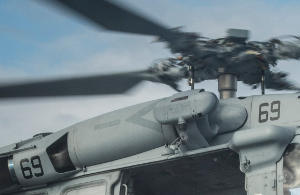
Photo: The gray tube you can see under the rotor of this US military Seahawk helicopter is one of its twin turboshaft engines. There's another one exactly the same on the other side. Photo by Trevor Kohlrus courtesy of US Navy.
You might not think helicopters are driven by jet engines—they have those huge rotors on top doing all the work—but you'd be wrong: the rotors are powered by one or two gas-turbine engines called turboshafts. A turboshaft is very different from a turbojet, because the exhaust gas produces relatively little thrust. Instead, the turbine in a turbojet captures most of the power and the driveshaft running through it turns a transmission and one or more gearboxes that spin the rotors. Apart from helicopters, you'll also find turboshaft engines in trains, tanks, and boats. Gas turbine engines mounted in things like power plants are also turboshafts.
Turboprops

Photo: A turboprop engine uses a jet engine to power a propeller. Photo by Eduardo Zaragoza courtesy of US Navy.
A modern plane with a propeller typically uses a turboprop engine. It's similar to the turboshaft in a helicopter but, instead of powering an overhead rotor, the turbine inside it spins a propeller mounted on the front that pushes the plane forward. Unlike a turboshaft, a turboprop does produce some forward thrust from its exhaust gas, but the majority of the thrust comes from the propeller. Since propeller-driven planes fly more slowly, they waste less energy fighting drag (air resistance), and that makes them very efficient for use in workhorse cargo planes and other small, light aircraft. However, propellers themselves create a lot of air resistance, which is one reason why turbofans were developed. Read more about turboprops from NASA.
Turbofans
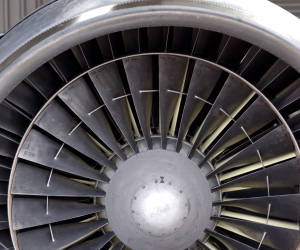
Photo: A turbofan engine produces more thrust using an inner fan and an outer bypass (the smaller ring you can see between the inner fan and the outer case). Each one of these engines produces 43,000 pounds of thrust (almost 4.5 times more than the Stratofortress engines up above)! Photo by Lance Cheung courtesy of US Air Force.
Giant passenger jets have huge fans mounted on the front, which work like super-efficient propellers. The fans work in two ways. They slightly increase the air that flows through the center (core) of the engine, producing more thrust with the same fuel (which makes them more efficient). They also blow some of their air around the outside of the main engine, "bypassing" the core completely and producing a backdraft of air like a propeller. In other words, a turbofan produces thrust partly like a turbojet and partly like a turboprop. Low-bypass turbofans send virtually all their air through the core, while high-bypass ones send more air around it. Impressive power and efficiency make turbofans the engines of choice on everything from passenger jets (typically using high-bypass) to jet fighters (low-bypass). The bypass design also cools a jet engine and makes it quieter. Read more about turbofans from NASA.
Ramjets and scramjets
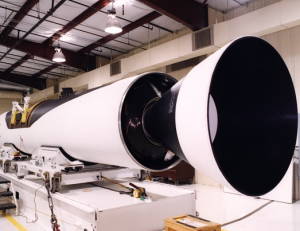
Photo: A Pegasus ramjet/scramjet engine developed for space planes in 1999. Photo by courtesy of NASA Armstrong Flight Research Center.
Jet engines scoop air in at speed so, in theory, if you designed the inlet as a rapidly tapering nozzle, you could make it compress the incoming air automatically, without either a compressor or a turbine to power it. Engines that work this way are called ramjets, and since they need the air to be traveling fast, are really suitable only for supersonic and hypersonic (faster-than-sound) planes. Air moving faster than sound as it enters the engine is compressed and slowed down dramatically, to subsonic speeds, mixed with fuel, and ignited by a device called a flame holder, producing a rocket-like exhaust similar to that made by a classic turbojet. Ramjets tend to be used on rocket and missile engines but since they "breathe" air, they cannot be used in space. Scramjets are similar, except that the supersonic air doesn't slow down anything like as much as it speeds through the engine. By remaining supersonic, the air exits at much higher speed, allowing the plane to go considerably faster than one powered by a ramjet (theoretically, up to Mach 15, or 15 times the speed of sound—in the "high hypersonic" region). Read more about ramjets and scramjets from NASA.

A brief history of jet engines
- ~1800s: Using simple models, English inventor Sir George Cayley (1773–1857) figures out the basic design and operation of the modern, wing-lifted airplane. Unfortunately, the only practical power source available during his lifetime is the coal-powered steam engine, which is too big, heavy, and inefficient to power a plane.
- 1860s–1870s: Working independently, French engineers Joseph Étienne Lenoir (1822–1900), German engineer Nikolaus Otto (1832–1891), and Karl Benz develop the modern car engine, which runs on relatively light, clean, energy-rich gasoline—a much more practical fuel than coal.
- 1884: Englishman Sir Charles Parsons (1854–1931) pioneers steam turbines and compressors, key pieces of technology in future airplane engines.
- 1903: Bicycle-making brothers Wilbur Wright (1867–1912) and Orville Wright (1871–1948) make the first powered flight using a gas engine to power two propellers fixed to the wings of a simple biplane.
- 1908: Frenchman René Lorin (1877–1933) invents the ramjet—the simplest possible jet engine.
- 1910: Henri-Marie Coandă (1885–1972), born in Romania but mostly working in France, builds the world's first jet-like plane, the Coandă-1910, powered by a large air fan instead of a propeller.
- 1914: US space pioneer Robert Hutchings Goddard (1882–1945) is granted his first two patents describing liquid-fueled, multi-stage rockets—ideas that will, many years later, help fire people into space.
- 1925: Pratt & Whitney (now one of the world's biggest aero-engine makers) builds its first engine, the nine-cylinder Wasp.
- 1928: German engineer Alexander Lippisch (1894–1976) puts rocket engines on an experimental glider to make the world's first rocket plane, the Lippisch Ente.
- 1926: British engineer Alan Griffith (1893–1963) proposes using gas turbine engines to power airplanes in a classic paper titled An Aerodynamic Theory of Turbine Design. This work makes Griffith, in effect, the theoretical father of the jet engine (his many contributions include figuring out that a jet engine compressor needs to use curved airfoil blades rather than ones with a simple, flat profile). Griffith later becomes a pioneer of turbojets, turbofans, and vertical takeoff and landing (VTOL) aircraft as the Chief Scientist to Rolls-Royce, one of the world's leading aircraft engine makers.
- 1928: Aged only 21, English engineer Frank Whittle (1907–1996) designs a jet engine, but the British military (and Alan Griffith, their consultant) refuse to take his ideas seriously. Whittle is forced to set up his own company and develop his ideas by himself. By 1937, he builds the first modern jet engine, but only as a ground-based prototype.
- 1936: Whittle invents and files a patent for the bypass turbofan engine.
- 1933–1939: Hans von Ohain (1911–1998), Whittle's German rival, simultaneously designs jet engines with compressors and turbines. His HeS 3B engine, designed in 1938, powers the Heinkel He-178 on its maiden flight as the world's first turbojet airplane on August 27, 1939.
- 1951: US aerospace engineer Charles Kaman (1919–2011) builds the first helicopter with a gas-turbine engine, the K-225.
- 2002: General Electric's GE90-115B turbofan becomes the world's most powerful engine, with a maximum thrust of 569kN (127,900 lbf).
Sponsored links
Find out more
On this website
- Airplanes
- Engines (general introduction)
- Hot-air balloons
- Parachutes
On other websites
- Airplane engines at the Smithsonian National Air and Space Museum: Browse wonderful photos of the Museum's impressive collection of 170 historic engines.
- Rivals for the skies: Learn more about the rival jet-engine designers Frank Whittle and Hans von Ohain.
Books
For older readers
- The Development of Jet and Turbine Aero Engines by Bill Gunston. PSL, 2006. Former RAF pilot Bill Gunston's numerous airplane books are well worth seeking out.
- Jet Engines: Fundamentals of Theory, Design, and Operation by Klaus Hünecke. Zenith, 2010. A very detailed book about the mechanics of how a jet engine works.
- Frank Whittle: Invention of the Jet by Andrew Nahum. Icon, 2005/2017. A biography of one of the jet engine's pioneers.
For younger readers
- Air and Space Travel by Chris Woodford, Facts on File, 2004. This is my own 96-page introduction to the history of air and space travel; the invention of the jet engine was a crucial bridge between the two. Suitable for young teens.
- Super Jumbo Jets: Inside and Out by Holly Cefrey, PowerPlus Books/Rosen, 2002. This book goes into just enough technical detail for younger readers, covering different types of jet engines, as well as broader details of how big planes stay in the sky. Suitable for ages 9–12.
Articles
- Boeing Patents Laser Nuclear Fusion Jet Engine by Evan Ackerman. IEEE Spectrum, July 10, 2015. Are nuclear powered planes remotely feasible? Yes, according to this Boeing patent.
- Watch GE Test Its Jet Engines by Putting Them Through Hell by Alexander George. Wired, November 27, 2014. How do you test an engine against water, ice, bird strikes, and snapping blades?
- An Airline Fleet Fueled by Natural Gas by Matthew L. Wald. The New York Times, October 25, 2012. Can we make planes cleaner and greener by running their engines on natural gas?
- Electric Arcs to Quiet Jets by Saswato R Das. IEEE Spectrum. August 1, 2004. How engineers are trying to redesign the airflow through engines to make them quieter.
- Biggest Jet Engine by Paul Eisenstein. Three-page article in Popular Science, July 2004. How the drive for faster, more economical, and quieter jet engines is making them even bigger.
- 21st-century Hot Jet Engines by Stuart F. Brown. Popular Science, June 1990. How engineers are trying to perfect engines with double the thrust.
Patents
I find it fascinating to explore inventors' ideas in their own words (and diagrams)—which is something you can do very easily by browsing patents. Here are a few I've selected that cover various types of jet engines:- US Patent: 2,168,726: Propulsion of aircraft and gas turbines by Frank Whittle. This isn't Whittle's original jet patent, but an older and more mature version of his ideas.
- US Patent: 2,508,288: Gas turbine power plant for aircraft by Francis Marchant, Bristol Aeroplane Co Ltd. A World War II jet engine design.
- US Patent: US2,519,130: Compound gas-turbine power plant with parallel flow turbines by Alan Griffith, Rolls Royce. A more complex turbofan from another great pioneer of jet engine technology.
Please do NOT copy our articles onto blogs and other websites
Text copyright © Chris Woodford 2006, 2016. All rights reserved. Full copyright notice and terms of use.
Text copyright © Chris Woodford 2006, 2016. All rights reserved. Full copyright notice and terms of use.



















No comments:
Post a Comment